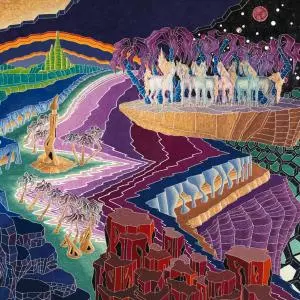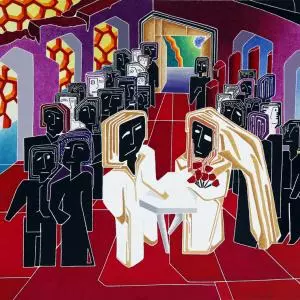Alternative Reality
City: Berlin
Space: Palazzo Italia
Address: Unter Den Linden 10
Period: 24th June to 9th July
Title: Alternative Reality
Artist: Francesco Visalli
Curator: P. Charlotte Stein Infantellina
Opening: 24th June
Preview: 24th June at 6 p.m.
Closing day: 9th July
Critical text: Paolo Levi
Catalogue: Editoriale Giorgio Mondadori
PR: Infantellina Contemporary
The Berlin leg of artist Francesco Visalli’s international tour and his personal “alternative reality” will be hosted in Palazzo Italia from 24th June to 9th July. Occupying such a prestigious space is even more important considering the fact that the show will take place during the Berlin Fashion Week: it will be an event within an event. So, like the clothing on the catwalks of Berlin, the show will feature a succession of paintings, colours, shapes, materials and thoughts. Passing in review, the universe of Francesco Visalli, a visionary of the real that does not create visions but communicates realities that represent other “alternative” dimensions, as the artist himself likes to define them. In these unexplored places (where interpenetrations of lines and shapes often result in unprecedented geometries), fragments of reality meet reminiscences and imagination. Present, past and future evolve within a subtle phenomenological play of “events”. Inexhaustible forms of interpretation are left open by playing with the intuition and distortion of the entities represented. Some aspects appear decontextualised, others are repeated or exemplified in other forms and by graphic lines that branch out through original geometries… (taken from the critical text “Le Euritmie del Caos” (The Eurhythmies of Chaos) by Rosi Raneri).
The artist’s entire portfolio will be on display in this one-man show, organised by P. Charlotte Stein Infantellina. The prestigious catalogue published by Editoriale Giorgio Mondadori will be enriched with critical text by Paolo Levi, who wished to give his valuable opinion of each work.
Biography
Francesco Visalli was born in 1960, the son of a postal worker and a teacher. He grew up in one of the poorest and most notorious areas of Rome, the “Borghetto Prenestino”, made infamous by Pier Paolo Pasolini”s “Ragazzi di Vita”.
His father died when he was 14 years old, an event which deeply affected his life.
Francesco, an only child, was forced to look for a job to support his mother and pay for his studies. One of the teachers at the technical school he attended found him a place in his firm, which enabled him to enrol in a faculty of architecture and go to live by himself at the age of 19. Francesco was determined, but he was also very young, and work, study and a house demanded commitment and sacrifices. His degree, which would provide him with a better life, was still in the distant future and he felt angry. He was troubled, very alone and afraid; but preferring not to dwell on his own feelings, he sought distraction in sex, drugs and bad company, and become a political extremist.
Then, when he was 21, he fell in love with a woman and followed her to Los Angeles: this was just the first of many transformations that would occur in his life. The woman he loved was rich and he lived surrounded by comfort. He continued to work, completing his studies, until he began to feel suffocated by the woman and her wealth. So he left everything and returned to Rome, where he could start afresh. Free and finally qualified, he set up a studio in his house, dedicating himself totally to his work.
At 25 years of age, he finally met the woman that was to be his great love. They married and he began a spiritual journey with her that changed him profoundly, helping him to find the deep meaning of his life in the Catholic faith.
The courage, faith and great strength of his marriage helped him to open up his professional life to success; he started his first design company, which produced important work in Italy and abroad, and then, still by himself, created two more companies. These were years of great victories, of economic fortune, of esteem and praise from many people, that were always accompanied by his deep faith and love for his wife. They were also years of miracles that he would never have dreamed of, such as the three children he had with his wife, even though medical opinion had declared him completely sterile.
Then, at 43 years of age, everything ended; Francesco fell into bitter delusion, lost his faith, saw everything fall apart and left his wife: these were his years of exile. He continued to work, but knew that he was not free, experiencing disappointment, failure, frustration, sickness and solitude. He finally threw in the towel and closed everything down, spending his time doing nothing: he was now 50 years old and had lived more than enough; what was the point of continuing, if everything was finished? This was his darkest hour.
On the night of 11 October, 2009, however, everything changed once more.
Francesco picked up a pen and began to draw things he had never seen before. He spent the entire night drawing, continuing the next day, the following night and so on, for days on end.
Francesco”s hand, as if guided by something divine, was rapidly moving around the white sheet of paper of its own joyful accord, producing fantastic drawings. Colours burst out and unusual shapes came to life from his hands. After a few weeks, the drawings became paintings. Although he had no knowledge of painting technique, he acquired it by working, finding within himself a style that already had its own very precise expressions and definition, which was his style. Each painting is a new discovery, and he deliberately keeps no records, does not study, has no desire to learn from others and does not look at the great masters, in order not to be conditioned by those that have preceded him. Visalli works like an erupting volcano, continuously drawing and painting whatever his instincts tell him. He passes through the classic creative phases, first producing the drawing and then choosing and applying the colours, without letting himself be encumbered by thought and without any mediation, almost as if in a trance. The relationship between the shapes and colour combinations in his paintings is the product of a harmony that is never deliberately sought, but discovered by chance each time. It is as if he unwraps each canvas to discover the colours that are already there, simply waiting to be revealed by him. He is amazed by the finished pictures that suddenly appear in front of him, like newly discovered portions of an unknown land, which is this strange new reality that he is living. Visalli did not consider and decide on painting as an alternative to his former profession; painting erupted into his life and chose him.
His shapes and geometry are defined by a subtle white line that runs between the colours, which never touch each other. The line is left by the canvas, because it is the canvas that designs the painting; his falsely seraphic figures form a subtle aperture between the eye of the observer and the soul of their creator, who, as if hiding from himself, “wants” to calm the vortex of his dramas and victories behind those distant and rather absent forms; or else hurl himself courageously towards new and infinite horizons, where beyond one heaven lies another, in scenes of a cosmic reality. He obtains incongruous results, rather like quietly shouting at the top of one”s voice, a freezing heat or a whirling stillness. His paintings bring to light his past and future life, without his involvement, like a flurry of pangs and torments viewed through the wrong end of a pair of binoculars, always moving a bit further beyond the heart, in an “Alternative Reality”.
(Biography edited by “Ich Traume”)
Critic Text by Paolo Levi: BEYOND THE FAIRY TALE
Following the creative itinerary of this very original painter, it is immediately clear that he is a talented artist, an initiate, a leading figure outside the Surrealist norms dictated by André Breton but not far removed from those connected to the suppression of dreams revealed by Sigmund Freud.Scrolling through the diverse collection of subjects treated by Francis Visalli, the first impression is that the artist suffers from a sort of compulsion to occupy the entire surface of the canvas with drawing of which he is a great and professional lover, dyeing it with a kaleidoscope of colours in an authentic swirl of shades.In reality, understanding his itinerary cannot be attributed simplistically to this or that kind of path. It is rather a refined search, a pleasant blend of entirely new expressive intents.Each of his paintings is made up of a series of emotional counterpoints, visual statements and references which transform themselves inside the complex architecture of the painting and become a metaphor for the innermost corners of thoughts. For this reason, the complexity of the work is inevitable. The painter moves with remarkable ease between different levels and rigidly separate universes, and what was irreconcilable just seconds earlier comes together on the canvas.The quality of the final composition seems to be forever suspended, poised between success and surrender, but Visalli is always able to regain control over his inspiration and translate it effectively, respecting the rules of formal balance. To give voice to this magic that is becoming a work of art, he develops narratives of signs that, step by step, reveal the endless possibilities of a fertile imagination, organising its narration in ordered sequences.His fanciful and dream-like constructions may, therefore, confuse critical judgment into defining him as a surrealist. Nothing could be further from the truth. Visalli is not an anomalous son of Breton, he does not offer us absurd and surreal imagery; on the contrary, his is a well-structured and organised reality, even if it is a reality constructed by the mind of a visionary.The painter stands in front of worlds deriving from the transcriptions of dreams – it matters little whether the result of daydreaming or dreaming – where he captures the sensations of life and cosmoses that, at the very moment of transforming them into paintings, have already become something different. His is not science fiction, it is construction and reinterpretation of moments existing in his unconscious, worlds that he manages to touch and share, thanks to his communicative sensitivity, with the observer.His works have a strong scenographic component and the person who fathoms these messages is left to decipher which script will be played out behind the scenes.In fact, Visalli plays with symbols and references, has fun with titles, likes to confuse the interpretative coordinates of what could be the plot of a fable, if seen by innocent eyes, or rather a story disguised as truth, with a more mature and disillusioned interpretation.The different levels of composition are therefore reflected in different levels of possible interpretation, amplifying the already multiple suggestions present in the works.The thin line that separates the true from the false loses meaning here, turned into a beautiful echo of symphonies, chasing each other on the canvas and ready to receive the notes of a cleverly orchestrated score.To give his life to these worlds, the painter uses oils, which he applies according to tonal and atonal game and without nuance. In his paintings there are no shadows: light and dark, if any, are slight flickers in the vision of the system he composes; colours are always separated by thin white lines, as if Visalli wanted to separate the elements to establish order in his colourful representations.The artist narrates the colourful extensions of his feelings in a natural way, making possible what the imagination relegates to the realm of the impossible, subverting all the rules, sometimes with irony, sometimes with dark and disturbing drama.But what is the genesis of the form in Visalli”s poetry?One thing we can say with certainty: his form is never preconceived, it is never an a priori style. It is a form that rises in the poetic and intellectual leavening of inspiration, that moves and stretches from inside, thanks to forces of arcane idealism.In conversation with this master of line and colour, it is easy to see that along with the fairy-tale motifs, found through a poignant poetic related to the dichotomy between dream and reality, there willingly also emerge pressures of the great visionary art of northern Europe.In this way we realise that the uneasy boundary between absence and presence, which is undoubtedly the basis of his creative ways, can be approached as a narrative about existence, which continually refers to man, and where the notion of good and evil merges with the denial or affirmation of universal values, beyond human and terrestrial boundaries. Each of his paintings, which always seems closed and concluded, send exalting messages, giving significant ethical warnings to the artist”s extraordinary figural inventions. His imaginative sensitivity is thus found to act within deep syntheses, awakened by a lofty feeling of which the meaning seemed to have been lost. The vision governs the painting and gives meaning to every part as an indispensable moment of its unity.
 Share / Save
Share / Save











Comments 0
Say something